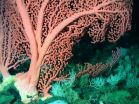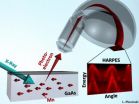(Press-News.org) Cold Spring Harbor, NY -- A team of neuroscientists has proposed a new and potentially revolutionary way of obtaining a neuronal connectivity map (the "connectome") of the whole brain of the mouse. The details are set forth in an essay published October 23 in the open-access journal PLOS Biology.
The team, led by Professor Anthony Zador, Ph.D., of Cold Spring Harbor Laboratory, aims to provide a comprehensive account of neural connectivity. At present the only method for obtaining this information with high precision relies on examining individual cell-to-cell contacts (synapses) in electron microscopes. But such methods are slow, expensive and labor-intensive.
Zador and colleagues instead propose to exploit high-throughput DNA sequencing to probe the connectivity of neural circuits at the resolution of single neurons.
"Our method renders the connectivity problem in a format in which the data are readable by currently available high-throughput genome sequencing machines," says Zador. "We propose to do this via a process we're now developing, called BOINC: the barcoding of individual neuronal connections."
The proposal comes at a time when a number of scientific teams in the U.S. are progressing in their efforts to map connections in the mammalian brain. These efforts use injections of tracer dyes or viruses to map neuronal connectivity at a "mesoscopic" scale—a mid-range resolution that makes it possible to follow neural fibers between brain regions. Other groups are scaling up approaches based on electron microscopy.
Zador's team wants to trace connectivity "beyond the mesoscopic," at the level of synaptic contacts between pairs of individual neurons, throughout the brain. The BOINC barcoding technique, now undergoing proof-of-concept testing, will be able, says Zador, "to provide immediate insight into the computations that a circuit performs." In practice, he adds, most neural computations are not currently understood at this level of precision, partly because detailed circuit information is not available for mammals. The BOINC method promises to be much faster and cheaper than approaches based on electron microscopy, Zador says.
The BOINC method consists of three steps. First, each neuron is labeled with a specific DNA barcode. A barcode consisting of just 20 random DNA "letters" can uniquely label a trillion neurons—many more than exist in the mouse brain.
The second step looks at neurons that are synaptically connected, and associates their respective barcodes with one other. One way to do this is by exploiting a virus such as the pseudorabies virus, which can move genetic material across synapses.
"To share barcodes across synapses, the virus must be engineered to carry the barcode within its own genetic sequence," explains Zador. "After the virus spreads across synapses, each neuron effectively ends up as a bag of barcodes, comprising its own code and those from synaptically coupled partners."
The third step involves joining barcodes from synaptically connected neurons to make single pieces of DNA, which can then be read via existing high-throughput DNA sequencing methods. These double-barcode sequences can then be analyzed computationally to reveal the synaptic wiring diagram of the brain.
Taken together, says Zador, if BOINC succeeds in its current proof-of-concept tests, it will offer a dramatically inexpensive and rapid means of assembling a connectome, even of the complex brains of mammals.
### "Sequencing the Connectome" appears in PLoS Biology on October 23, 2012. The authors are: Anthony M. Zador, Joshua Dubnau, Hassana K. Oyibo, Huiqing Zhan, Cao Gang and Ian D. Peikon. The paper can be obtained at: http://www.plosbiology.org
About Cold Spring Harbor Laboratory
Founded in 1890, Cold Spring Harbor Laboratory (CSHL) has shaped contemporary biomedical research and education with programs in cancer, neuroscience, plant biology and quantitative biology. CSHL is ranked number one in the world by Thomson Reuters for impact of its research in molecular biology and genetics. The Laboratory has been home to eight Nobel Prize winners. Today, CSHL's multidisciplinary scientific community is more than 360 scientists strong and its Meetings & Courses program hosts more than 12,500 scientists from around the world each year to its Long Island campus and its China center. Tens of thousands more benefit from the research, reviews, and ideas published in journals and books distributed internationally by CSHL Press. The Laboratory's education arm also includes a graduate school and programs for undergraduates as well as middle and high school students and teachers. CSHL is a private, not-for-profit institution on the north shore of Long Island. For more information, visit www.cshl.edu.
Neuroscientists propose revolutionary DNA-based approach to map wiring of whole brain
Novel approach to assembling the 'connectome' via genetic barcoding
2012-10-24
ELSE PRESS RELEASES FROM THIS DATE:
Twitter principles of social networking increase family success in nesting birds
2012-10-24
New research carried out by scientists at Universities in Exeter, France and Switzerland reveals for the first time the importance of social networking in producing a successful family.
The study found that, regardless of how big and healthy individual chicks are, what really matters to their chances of surviving and breeding is how siblings in the nest interact with each other, with cooperative families faring best.
Differences in patterns of feeding between mothers and fathers were a key factor in determining the behaviour of their offspring, according to the study ...
Summer babies less likely to be CEOs: UBC research
2012-10-24
Sauder School of Business researchers at the University of British Columbia have found that a person's date of birth can affect their climb up the corporate ladder.
The Sauder study shows that only 6.13 per cent of an S&P 500 CEO sample was born in June and only 5.87 per cent of the sample was born in July. By comparison, people born in March and April represented 12.53 per cent and 10.67 per cent of the sample of CEOs.
"Our findings indicate that summer babies underperform in the ranks of CEOs as a result of the 'birth-date effect,' a phenomenon resulting from the ...
Blood chromosome differences are linked to pancreatic cancer
2012-10-24
MADISON – A new study shows that a blood marker is linked to pancreatic cancer, according to a study published today by scientists at the University of Wisconsin Carbone Cancer Center and Mayo Clinic.
First author Dr. Halcyon Skinner, assistant professor of population health sciences at the University of Wisconsin School of Medicine and Public Health, says the study is the first time pancreatic cancer risk has been linked to differences in telomeres' length in blood cells.
"This suggests a new avenue to identify those with pancreatic cancer or those at risk of developing ...
Genetic patterns of deep-sea coral provide insights into evolution of marine life
2012-10-24
The ability of deep-sea corals to harbor a broad array of marine life, including commercially important fish species, make these habitat-forming organisms of immediate interest to conservationists, managers, and scientists. Understanding and protecting corals requires knowledge of the historical processes that have shaped their biodiversity and biogeography.
While little is known about these processes, new research described in the journal Molecular Ecology helps elucidate the historical patterns of deep-sea coral migration and gene flow, coincident with oceanic circulation ...
New finding could pave way to faster, smaller electronics
2012-10-24
University of California, Davis, researchers for the first time have looked inside gallium manganese arsenide, a type of material known as a "dilute magnetic semiconductor" that could open up an entirely new class of faster, smaller devices based on an emerging field known as "spintronics."
Materials of this type might be used to read and write digital information not by using the electron's charge, as is the case with today's electronic devices, but by using its "spin."
Understanding the magnetic behavior of atoms is key to designing spintronics materials that could ...
New paper examines shifting gears in the circadian clock of the heart
2012-10-24
A new study conducted by a team of scientists led by Giles Duffield, assistant professor of biological sciences and a member of the Eck Institute for Global Health at the University of Notre Dame focuses on the circadian clock of the heart, and used cultured heart tissue. The results of the new study have implications for cardiovascular health, including daily changes in responses to stress and the effect of long-term rotational shift work.
Previous studies by a research group at the University of Geneva demonstrated a role for glucocorticoids in shifting the biological ...
Droplet response to electric voltage in solids exposed
2012-10-24
DURHAM, N.C. – For the first time, scientists have observed how droplets within solids deform and burst under high electric voltages.
This is important, the Duke University engineers who made the observations said, because it explains a major reason why such materials as insulation for electrical power lines eventually fail and cause blackouts. This observation not only helps scientists develop better insulation materials, but could also lead to such positive developments as "tunable" lenses for eyes.
As the voltage increases, water droplets, or air bubbles, within ...
Analysis of dinosaur bone cells confirms ancient protein preservation
2012-10-24
A team of researchers from North Carolina State University and the Palo Alto Research Center (PARC) has found more evidence for the preservation of ancient dinosaur proteins, including reactivity to antibodies that target specific proteins normally found in bone cells of vertebrates. These results further rule out sample contamination, and help solidify the case for preservation of cells – and possibly DNA – in ancient remains.
Dr. Mary Schweitzer, professor of marine, earth and atmospheric sciences with a joint appointment at the North Carolina Museum of Natural Sciences, ...
NJIT math professor calls Detroit Tigers a favorite to win World Series
2012-10-24
Since the Major League Baseball Division Series and League Championship Series have determined which teams will compete in the World Series, NJIT Math Professor Bruce Bukiet has again analyzed the probability of each team taking the title.
"The Detroit Tigers have a solid advantage over the San Francisco Giants. The Tigers, who surprisingly swept the New York Yankees in four straight games in the American League Championship Series to reach the World Series, have a 58 percent chance of beating the Giants in the best of seven series," he said.
At the season's start, ...
Medical recommendations should go beyond race, scholar says
2012-10-24
EAST LANSING, Mich. — Medical organizations that make race-based recommendations are misleading some patients about health risks while reinforcing harmful notions about race, argues a Michigan State University professor in a new paper published in the journal Preventive Medicine.
While some racial groups are on average more prone to certain diseases than the general population, they contain "islands" of lower risk that medical professionals should acknowledge, said Sean Valles, assistant professor in MSU's Lyman Briggs College and the Department of Philosophy.
For instance, ...
LAST 30 PRESS RELEASES:
Norbert Holtkamp appointed director of Fermi National Accelerator Laboratory
New agentic AI platform accelerates advanced optics design
Biologists discover neurons use physical signals — not electricity — to stabilize communication
Researchers discover that a hormone can access the brain by hitchhiking
University of Oklahoma researcher awarded funding to pursue AI-powered material design
Exploring how the visual system recovers following injury
Support for parents with infants at pediatric check-ups leads to better reading and math skills in elementary school
Kids’ behavioral health is a growing share of family health costs
Day & night: Cancer disrupts the brain’s natural rhythm
COVID-19 vaccination significantly reduces risk to pregnant women and baby
The role of vaccination in maternal and perinatal outcomes associated with COVID-19 in pregnancy
Mayo Clinic smartwatch system helps parents shorten and defuse children's severe tantrums early
Behavioral health spending spikes to 40% of all children’s health expenditures, nearly doubling in a decade
Digital cognitive behavioral treatment for generalized anxiety disorder
Expenditures for pediatric behavioral health care over time and estimated family financial burden
Air conditioning in nursing homes and mortality during extreme heat
The Alps to lose a record number of glaciers in the next decade
What makes a good proton conductor?
New science reporting guide published for journalists in Bulgaria
New international study reveals major survival gaps among children with cancer
New science reporting guide published for journalists in Turkey
Scientists develop a smarter mRNA therapy that knows which cells to target
Neuroanatomy-informed brain–machine hybrid intelligence for robust acoustic target detection
Eight SwRI hydrogen projects funded by ENERGYWERX
The Lundquist Institute and its start-up company Vitalex Biosciences Announces Strategic Advancement of Second-Generation fungal Vaccine VXV-01 through Phase 1 Trials under $40 Million Competitive Con
Fine particles in pollution are associated with early signs of autoimmune disease
Review article | Towards a Global Ground-Based Earth Observatory (GGBEO): Leveraging existing systems and networks
Penn and UMich create world’s smallest programmable, autonomous robots
Cleveland researchers launch first major study to address ‘hidden performance killer’ in athletes
To connect across politics, try saying what you oppose
[Press-News.org] Neuroscientists propose revolutionary DNA-based approach to map wiring of whole brainNovel approach to assembling the 'connectome' via genetic barcoding




